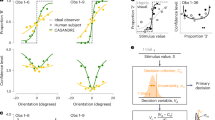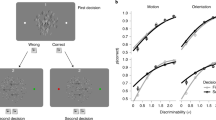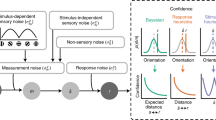Abstract
Confidence is the ‘feeling of knowing’ that accompanies decision-making. Bayesian theory proposes that confidence is a function solely of the perceived probability of being correct. Empirical research has suggested, however, that different individuals may perform different computations to estimate confidence from uncertain evidence. To test this hypothesis, we collected confidence reports in a task in which subjects made categorical decisions about the mean of a sequence. We found that for most individuals, confidence did indeed reflect the perceived probability of being correct. However, in approximately half of them, confidence also reflected a different probabilistic quantity: the perceived uncertainty in the estimated variable. We found that the contribution of both quantities was stable over weeks. We also observed that the influence of the perceived probability of being correct was stable across two tasks, one perceptual and one cognitive. Overall, our findings provide a computational interpretation of individual differences in human confidence.
This is a preview of subscription content, access via your institution
Access options
Access Nature and 54 other Nature Portfolio journals
Get Nature+, our best-value online-access subscription
$29.99 / 30 days
cancel any time
Subscribe to this journal
Receive 12 digital issues and online access to articles
$119.00 per year
only $9.92 per issue
Buy this article
- Purchase on Springer Link
- Instant access to full article PDF
Prices may be subject to local taxes which are calculated during checkout






Similar content being viewed by others
References
Meyniel, F., Schlunegger, D. & Dehaene, S. The sense of confidence during probabilistic learning: a normative account. PLoS Comput. Biol. 11, e1004305 (2015).
Yeung, N. & Summerfield, C. Metacognition in human decision-making: confidence and error monitoring. Phil. Trans. R. Soc. Lond. B 367, 1310–1321 (2012).
Bahrami, B. et al. Optimally interacting minds. Science 329, 1081–1085 (2010).
Bahrami, B. et al. What failure in collective decision-making tells us about metacognition. Phil. Trans. R. Soc. Lond. B 367, 1350–1365 (2012).
Tetlock, P. in Expert Political Judgment: How Good Is It? How Can We Know? (Princeton University Press, Princeton, New Jersey, 2005).
Graziano, M. & Sigman, M. The spatial and temporal construction of confidence in the visual scene. PLoS ONE 4, e4909 (2009).
Ais, J., Zylberberg, A., Barttfeld, P. & Sigman, M. Individual consistency in the accuracy and distribution of confidence judgments. Cognition 146, 377–386 (2016).
Fleming, S. M., Weil, R. S., Nagy, Z., Dolan, R. J. & Rees, G. Relating introspective accuracy to individual differences in brain structure. Science 329, 1541–1543 (2010).
Barttfeld, P. et al. Distinct patterns of functional brain connectivity correlate with objective performance and subjective beliefs. Proc. Natl Acad. Sci. USA 110, 11577–11582 (2013).
De Martino, B., Fleming, S. M., Garrett, N. & Dolan, R. J. Confidence in value-based choice. Nat. Neurosci. 16, 105–110 (2013).
Aitchison, L., Bang, D., Bahrami, B. & Latham, P. E. Doubly Bayesian analysis of confidence in perceptual decision-making. PLoS Comput. Biol. 11, e1004519 (2015).
Kepecs, A. & Mainen, Z. F. A computational framework for the study of confidence in humans and animals. Phil. Trans. R. Soc. Lond. B 367, 1322–1337 (2012).
Meyniel, F., Sigman, M. & Mainen, Z. F. Confidence as Bayesian probability: from neural origins to behavior. Neuron 88, 78–92 (2015).
Pouget, A., Drugowitsch, J. & Kepecs, A. Confidence and certainty: distinct probabilistic quantities for different goals. Nat. Neurosci. 19, 366–374 (2016).
Sanders, J., Hangya, B. & Kepecs, A. Signatures of a statistical computation in the human sense of confidence. Neuron 90, 499–506 (2016).
Tversky, A. & Kahneman, D. Judgment under uncertainty: heuristics and biases. Science 185, 1124–1131 (1974).
Navajas, J., Bahrami, B. & Latham, P. E. Post-decisional accounts of biases in confidence. Curr. Opin Behav. Sci. 11, 55–60 (2016).
Pouget, A., Deneve, S. & Latham, P. E. in Visual Attention and Cortical Circuits (eds Braun, J., Koch, C. & Davis, J.) 265–283 (MIT Press, Cambridge, 2001).
Moreno-Bote, R. et al. Information-limiting correlations. Nat. Neurosci. 17, 1410–1417 (2014).
Hangya, B., Sanders, J. I. & Kepecs, A. A mathematical framework for statistical decision confidence. Neural Comput. 28, 1840–1858 (2016).
McCullagh, P. Regression models for ordinal data. J. Roy. Statist. Soc. B 42, 109–142 (1980).
Petrusic, W. M. & Baranski, J. V. Judging confidence influences decision processing in comparative judgments. Psychon. Bull. Rev 10, 177–183 (2003).
Pleskac, T. J. & Busemeyer, J. R. Two-stage dynamic signal detection: a theory of choice, decision time, and confidence. Psychol. Rev. 117, 864 (2010).
Kepecs, A., Uchida, N., Zariwala, H. A. & Mainen, Z. F. Neural correlates, computation and behavioural impact of decision confidence. Nature 455, 227–231 (2008).
Lak, A. et al. Orbitofrontal cortex is required for optimal waiting based on decision confidence. Neuron 84, 190–201 (2014).
Kiani, R. & Shadlen, M. N. Representation of confidence associated with a decision by neurons in the parietal cortex. Science 324, 759–764 (2009).
van den Berg, R. et al. A common mechanism underlies changes of mind about decisions and confidence. Elife 5, e12192 (2016).
Barthelme, S. & Mamassian, P. Flexible mechanisms underlie the evaluation of visual confidence. Proc. Natl Acad. Sci. USA 107, 20834–20839 (2010).
Pescetelli, N., Rees, G. & Bahrami, B. The perceptual and social components of metacognition. J. Exp. Psychol. Gen. 145, 949 (2016).
Fleming, S. M., Dolan, R. J. & Frith, C. D. Metacognition: computation, biology and function. Phil. Trans. R. Soc. Lond. B 367, 1280–1286 (2012).
Fleming, S. M., Ryu, J., Golfinos, J. G. & Blackmon, K. E. Domain-specific impairment in metacognitive accuracy following anterior prefrontal lesions. Brain 137, 2811–2822 (2014).
Zylberberg, A., Roelfsema, P. R. & Sigman, M. Variance misperception explains illusions of confidence in simple perceptual decisions. Conscious. Cogn. 27, 246–253 (2014).
de Gardelle, V. & Mamassian, P. Weighting mean and variability during confidence judgments. PLoS ONE 10, e0120870 (2015).
Pouget, A., Beck, J. M., Ma, W. J. & Latham, P. E. Probabilistic brains: knowns and unknowns. Nat. Neurosci. 16, 1170–1178 (2013).
van Bergen, R. S., Ma, W. J., Pratte, M. S. & Jehee, J. F. Sensory uncertainty decoded from visual cortex predicts behavior. Nat. Neurosci. 18, 1728 (2015).
Nieder, A. & Dehaene, S. Representation of number in the brain. Annu. Rev. Neurosci. 32, 185–208 (2009).
Neisser, U. et al. Intelligence: knowns and unknowns. Am. Psychol. 51, 77–101 (1996).
Goldberg, L. R. The structure of phenotypic personality traits. Am. Psychol. 48, 26–34 (1993).
Kanai, R. & Rees, G. The structural basis of inter-individual differences in human behaviour and cognition. Nat. Rev. Neurosci. 12, 231–242 (2011).
Dubois, J. & Adolphs, R. Building a science of individual differences from fMRI. Trends Cogn. Sci. 20, 425–443 (2016).
van Gaal, S., Scholte, H. S., Lamme, V. A., Fahrenfort, J. J. & Ridderinkhof, K. R. Pre-SMA gray-matter density predicts individual differences in action selection in the face of conscious and unconscious response conflict. J. Cogn. Neurosci. 23, 382–390 (2011).
Schwarzkopf, D. S., Song, C. & Rees, G. The surface area of human V1 predicts the subjective experience of object size. Nat. Neurosci. 14, 28–30 (2011).
Smith, S. M. et al. A positive-negative mode of population covariation links brain connectivity, demographics and behavior. Nat. Neurosci. 18, 1565–1567 (2015).
Kanai, R., Bahrami, B., Roylance, R. & Rees, G. Online social network size is reflected in human brain structure. Proc. Biol. Sci. 279, 1327–1334 (2012).
Weil, L. G. et al. The development of metacognitive ability in adolescence. Conscious. Cogn. 22, 264–271 (2013).
Palmer, E. C., David, A. S. & Fleming, S. M. Effects of age on metacognitive efficiency. Conscious. Cogn. 28, 151–160 (2014).
David, A. S., Bedford, N., Wiffen, B. & Gilleen, J. Failures of metacognition and lack of insight in neuropsychiatric disorders. Phil. Trans. R. Soc. Lond. B 367, 1379–1390 (2012).
Acknowledgements
J.N. and B.B. were supported by the European Research Council StG (NEUROCODEC, no. 309865); C.H. was supported by a studentship from the Medical Research Council (UK); H.F. was supported by a Chevening scholarship; M.K. and P.E.L. were supported by the Gatsby Charitable Foundation. The funders had no role in study design, data collection and analysis, decision to publish or preparation of the manuscript.
Author information
Authors and Affiliations
Contributions
J.N. and B.B. designed the experiments. J.N., C.H. and H.F. conducted the experiments. J.N., M.K., P.E.L. and B.B. developed the analysis approach and computational models. J.N. analysed the data. J.N., P.E.L. and B.B. wrote the paper.
Corresponding author
Ethics declarations
Competing interests
The authors declare no competing interests.
Additional information
Publisher’s note: Springer Nature remains neutral with regard to jurisdictional claims in published maps and institutional affiliations.
Electronic supplementary material
Supplementary Information
Supplementary Notes, Supplementary Figures 1–8, Supplementary References
Rights and permissions
About this article
Cite this article
Navajas, J., Hindocha, C., Foda, H. et al. The idiosyncratic nature of confidence. Nat Hum Behav 1, 810–818 (2017). https://doi.org/10.1038/s41562-017-0215-1
Received:
Accepted:
Published:
Issue Date:
DOI: https://doi.org/10.1038/s41562-017-0215-1
This article is cited by
-
The expression of decision and learning variables in movement patterns related to decision actions
Experimental Brain Research (2024)
-
Prior information differentially affects discrimination decisions and subjective confidence reports
Nature Communications (2023)
-
Majority rule can help solve difficult tasks even when confident members opt out to serve individual interests
Scientific Reports (2023)
-
Rational arbitration between statistics and rules in human sequence processing
Nature Human Behaviour (2022)
-
Subjective confidence reflects representation of Bayesian probability in cortex
Nature Human Behaviour (2022)



